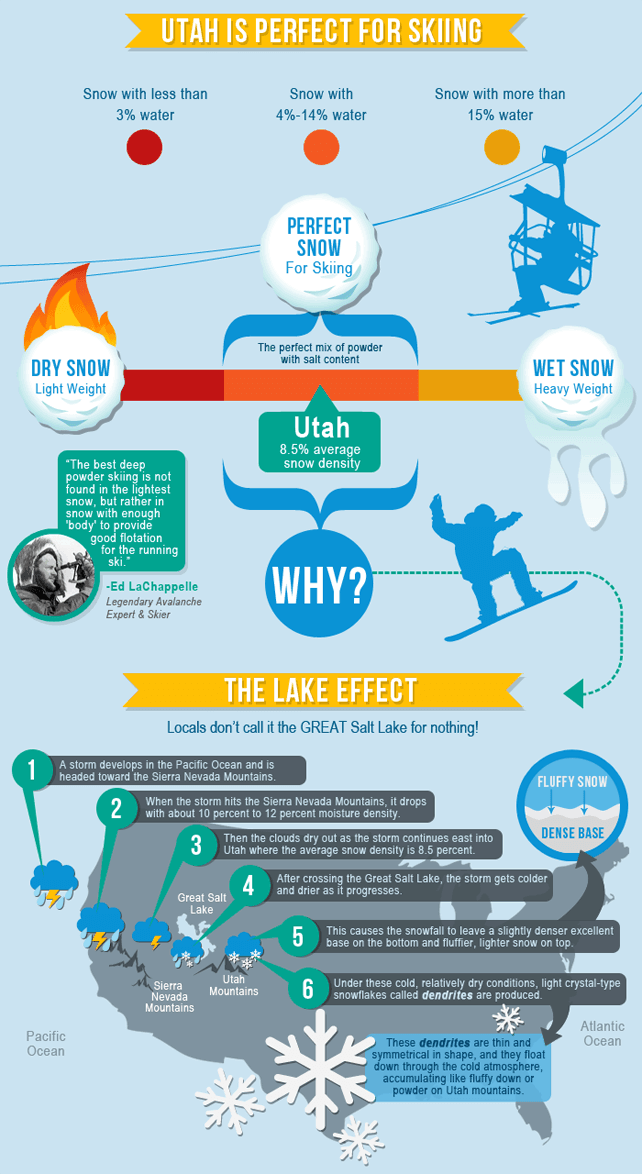
Since 1962 it’s been trademarked as The Greatest Snow on Earth®: and is highly rated throughout the skiing world. But what really makes Utah snow so special, and its resorts a place of pilgrimage for powerhounds?
Here are two big reasons, for starters.
1. There’s lots of it
The snowfall averages for the ski resorts east of Salt Lake City are impressive. The Canyons, near Park City, claims 9.01m of snow a winter. Solitude, one valley south of that, in Big Cottonwood Canyon, gets 12.70m, and Alta, a step further south, in Little Cottonwood Canyon, reports a whopping 14.22m.
These are not the highest snowfall averages in the skiing world. Mount Baker in Washington State tops that list, with 16.3m (it also has the record for the snowiest season ever: a whopping 29m in the winter of 1998-9). But they’re close. To put that into perspective, Val d’Isere in the French Alps averages around 5.2m a season, while little Warth-Schroecken in Austria is the snowiest resort in the Alps, with an average of just over 10m a year.
To give you an idea of how Utah snow can stack up, check out this delirious, and delicious, youtube clip from Snowbird, back in April 2010. Most ski films merely show you what a powder day looks like. This one gives you a sense of what that mix of flat-out commitment and wide-eyed wonder feels like, too…
Why does it snow so much? Well, the fact that most of Utah’s storm systems come from the world’s biggest ocean certainly helps. But local geography has an impact too. The Great Salt Lake, north-west of the city, warms the approaching air and aids moisture. The warm air rises, cools and starts to drop its snow – a phenomenon known as Lake-Effect Snow. Then the air hits the north-south wall of the Wasatch mountains, rises and cools still further – and bingo. It really snows. Recent research has also shown that in Utah the Lake Effect is further enhanced by the topography along its approach: the mountains it crosses en route to the Great Salt Lake funnel the air over the water, and intensify the process.
2. It gets lighter and drier as it falls
Most of Utah’s snow comes from cold-front Pacific storms – and it’s long been said that the reason Utah snow is so light and fluffy is because the air dries out as it heads towards Salt Lake City, across the deserts of the Great Basin.
But just as important is the fact that once these storms hit Utah, the temperature often drops sharply while the snow falls. Local meteorologists James Steenburgh and Trevor Alcott emphasise this point in their paper, Secrets of the “Greatest Snow on Earth”. Snow falling when it’s cold is lighter and drier than that when it’s milder. So Utah ski resorts usually get a fairly dense base of wet snow at the start of a storm, followed by much lighter powder during its middle and final stages.
This is known as “right-side up” snow. The higher density at the bottom provides good cover over old snow, fallen trees and rocks. The light powder on top provides the flotation, and the fun.
How light is this kind of powder? This light…
In fact, it’s so light, it has a tendency to fly up off your ski tips into your face, too, creating the famous ‘face shots’ of Utah skiing. Here are fifteen of ’em, filmed at the Canyons, near Park City.
Obviously, you can’t see a thing when you’re getting face shots. But no-one seems to care. After all, being out on a day like this is an amazing feeling: as if you were skiing air, rather than snow.
Here comes the caveat
There is one important “but” to all of this. Because even in Utah it doesn’t snow all the time: especially if a big area of high pressure forms over the eastern Pacific near California, and blocks the march of weather fronts in from the ocean. When that happens it can be dry for for weeks.
Few skiers – aside from the locals – can drop everything at the last minute to catch a storm, so if you’re planning a trip, consider building a little lack-of-snowfall insurance into your itinerary. By that I mean making sure you have access to plenty of piste/trail based-skiing which doesn’t need fresh powder to be fun. That way you can still have a blast if the storms don’t materialise.
So consider splitting your time between two locations, such as the Canyons, on the edge of Park City, and Snowbird and Alta in Little Cottonwood Canyon – or hiring a car so you can drive between them. Little Cottonwood Canyon usually gets the heaviest snow from a Wasatch snowstorm. Meanwhile, the Canyons offers a skiing experience which is less dependent on heavy snow: courtesy of 182 trails as well as natural half-pipes and terrain parks. From 2015 it will be connected to Park City Resort next door, offering 7,000 acres of interconnected skiing. Both areas are a short drive from Salt Lake City airport.
(British skiers can book a tailor-made flights-and-accommodation package to Utah with Ski Independence.)

Right, here’s that infographic I was talking about earlier…














Why Utah Snow is Special https://t.co/As21hwXElc